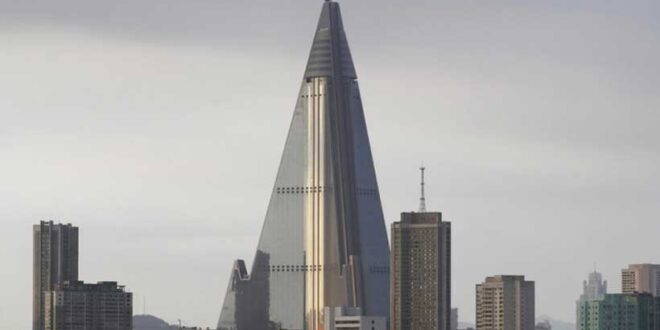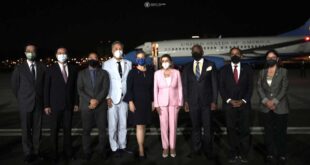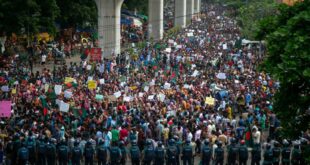Alexander Volontsov
An important event occurred at the 14th Supreme People’s Assembly (SPA) of the Democratic People’s Republic of Korea (DPRK), which was immediately thrust into a harsh spotlight worldwide: passing the DPRK Nuclear Force Policy Act. This document has both an international law dimension, as it concerns the global non-proliferation regime, and a regional dimension tied to the modalities of the political and military situation on the Korean Peninsula, and how it has been evolving.
First of all, it should be emphasized that this legislation is an important link in Pyongyang’s strategic policy of asserting its status as a nuclear weapon state and gaining international recognition in this capacity.
The enactment of the bill came as a surprise. This step might have seemed redundant, since the DPRK has already done enough in the legal field to assert the legitimacy of the national nuclear forces. In 2013, the Nuclear Weapons Law (NWL) was passed, and then the nuclear status provision was introduced into the nation’s Constitution, the most important and statutory instrument for any nation.
However, there was certain logic in passing that bill by the Northerners. First, the preceding legal acts had been rather brief, failing to disclose important provisions and specifics in respect to nuclear weapons. At major Track II diplomacy conferences as well as in other situations, we often heard the following remarks addressed to North Korean representatives: if you claim to be a nuclear state, then at least present your nuclear doctrine to the global community, which all members of the “nuclear five” have developed and which would define the nature, objectives, functions, terms of use, and storage of nuclear weapons, etc. The DPRK representatives could not say anything meaningful to these questions, since no national nuclear doctrine had been developed. The new law, as compared to some previous documents, is certainly a much more detailed and thoroughly elaborated piece of legislation.
The decree includes eleven sections containing provisions on the purpose of nuclear weapons, the composition of nuclear forces, their command and control, as well as obligations of the DPRK as a responsible nuclear state regarding the non-proliferation of its nuclear weapons and technologies to other countries. The document outlines the principles and terms of its use, mobilization, safe maintenance and protection, mass reinforcement, renewal, etc. The intended purpose of the new Act is clearly defined: “Publication of the policy in relation to the armed forces and the legal framework for DPRK’s use of nuclear weapons is aimed at preventing a fallible judgment between nuclear states and the misuse of nuclear weapons – ultimately, at radical reduction of the risk of nuclear war.” This document may claim the status of a nuclear doctrine, and it seems that Pyongyang has tried to present it as such. When viewed objectively, the decree contributes to statutory recognition of DPRK’s status as a nuclear-weapon state.
Second, Pyongyang’s espousing of the law can now be seen as a response to the “escalation of hostilities” on the part of Washington and Seoul (these are the terms traditionally used in North Korea). If the international environment were relatively favorable to the DPRK, as it was under Donald Trump who regularly exchanged personal friendly letters with Kim Jong-un, while we witnessed a high-level discourse with the U.S. and South Korea coupled with a mutual restraint in the military domain, – such an environment would probably bar Pyongyang from focusing on nukes, and such a bill could never have been promulgated.
However, over the past year and a half, Pyongyang could see that today’s leadership in both Washington and Seoul are ratcheting up confrontation and brinkmanship. Amidst the latest steps taken by the United States and its allies in the region, which include an intensification of military exercises, it is rather difficult to convince the DPRK that its security can be ensured by political instruments rather than via military and technical means. Indeed, under Joe Biden and the new president of the ROK, pressure has been mounting on the DPRK. With Yoon Seok-yol taking the helm in South Korea, his right-conservative team has formulated the doctrine of “deterring North Korean provocations by way of overwhelming military force,” which in practice is being transformed into a policy of confrontation.
With such a strategy at play, Seoul not only forecasts but also widely discusses the likelihood of local clashes with DPRK army units on a practical level, including in areas along the DMZ. Under the new president, dangerous statements about the advisability of a preventive strike against DPRK missile sites, which to many analysts seemed to be a mere side effect of his election campaign, were picked up by other high-ranking officials who follow up with this madcap rant.
The first public exchange of stern warnings between Seoul and Pyongyang took place in the spring of 2022, when South Korean Defense Minister Seo Wook stressed on 1 April that the South Korean military is equipped “with the capability and position to deliver a precision strike at the launch site” if there are clear signs of missile firing. His remarks were in line with President Yoon Seok-yeol’s policy of a preemptive strike to stop North Korea’s attack. He also called North Korea “the enemy” again, for the first time after a long break.
The next day, there followed a response from Secretary of WPK Central Committee Kim Yo-jeong, the sister of North Korea’s leader, who suggested that the South Koreans should think twice about the consequences before threatening a nuclear-armed state with a military strike. Nevertheless, three days later, in continuation of the entioned controversy, Yoon Seok-yeol’s spokeswoman confirmed that “a preemptive strike remains an option which South Korea can take in case of an imminent threat.”
For Pyongyang, an important signal to the “hopelessness” of diplomatic efforts was the return of Washington and Seoul to the CVID (Complete, Verifiable, Irreversible Dismantlement) First formula repeatedly rejected by Pyongyang. The formula implies practical steps to be taken by the North towards complete, verifiable and irreversible disarmament that should precede dialogue and possibility of broad economic assistance. This approach was reiterated by President Yoon Seok-yol in his keynote address on August 15, 2022. Therefore, Pyongyang now sees no room for negotiations. No diplomatic prospects for resolving the problem are in view. Kim Yo-jeong, in her harsh analysis of the South Korean leader’s “bold proposal”, formulated the perspective of inter-Korean relations for the period of his presidency: “Let’s live as though we’re unconscious of each other: this is our fervent wish.”
Moreover, it appears that the full-scale U.S.-South Korean exercises Ulchi Freedom Shield, held from August 22 to September 1, 2022, were resumed for the first time since 2017 and will continue. In addition, official Seoul says that it will pursue a policy from a position of strength, because “only increased pressure and sanctions” can convince Pyongyang to embark upon the path of nuclear disarmament.
The short-sightedness of the current U.S. and ROK authorities is surprising. This situation has been observed more than once, and so Pyongyang, by passing a nuclear policy decree, has decided to reaffirm its position that DPRK’s nuclear capabilities are non-negotiable. It did this so that no one would cherish any illusions, and also to remind that, in case anyone has forgotten, the Constitution of the DPRK stipulates the country’s status of a nuclear-weapon state. This status is also enshrined in the military doctrine. The adopted bill confirms just that, to frustrate futile hopes to press the North into renunciation of nuclear weapons. Therefore, the new law stresses, among other things, that Pyongyang will not even negotiate denuclearization, given that the possession of nuclear weapons is its legitimate and inalienable right.
It appears that certain clauses of the new act were formulated under constant threats from the U.S.-South Korean military alliance as a reaction to the specific steps of Seoul and Washington. Commenting on the ROK Head’s “bold initiative” to “entice DPRK into renunciation of nuclear weapons in exchange for economic aid,” Kim Jong-un emphasized in his speech at the session of the DPRK Supreme People’s Assembly on September 8, 2022: “Our generation will not succumb to the enemy’s insidious preaching or give in to its persistent pressure only for the sake of its own well-being and to avoid the hardships encountered today; nor will it desire any visible economic improvements or higher living standards at the cost of giving up nuclear weapons, this guarantor of our Republic’s security and the security of generations to come.”
Obviously, in response to the ongoing hunt for the DPRK leader—it is well known that U.S. intelligence, including space intelligence, and the ROK are closely and constantly monitoring all of Kim Jong-un’s movements around the country, his residences, etc., while certain officials in Washington and Seoul have repeatedly expressed their willingness to deliver a “decapitation strike”, that is, a preventive strike to eliminate Kim Jong-un and his immediate circle—the bill provides for the DPRK to deliver a preventive nuclear strike “in case of an imminent actual or potential nuclear and non-nuclear attack by hostile forces against the national leadership and the command structure of the national nuclear armed forces.”
In response to the bellicose statements of Defense Minister in the Yun Seok Yeol’s administration, Pyongyang included the following warning in the new act: “The DPRK does not threaten nuclear strikes or the use of nukes against non-nuclear states, unless the latter have participated in aggression or offensive actions against the DPRK in collusion with other nuclear states.”
It appears that since the spring of 2022 the United States and South Korea have simply been pushing and essentially provoking the DPRK to conduct a nuclear test as soon as possible. Officials in Washington and Seoul speak about it with full confidence as a fait accompli, naming specific dates. They mentioned May 9 (President Yun Seok-yol’s inauguration), then May 19 as the date of President Biden’s visit to Korea, and late August being the period of joint U.S.-South Korean maneuvers. These predictions, as we know, did not come true, but there was constant brinkmanship in the media. Later on, they mentioned major political holidays of North Korea: September 9 – the Republic Foundation Day, and October 10 – the WPK Foundation Day.
>Finally, Pyongyang responded to these persistent calls—on the eve of DPRK Foundation Day, it “blew” an A-bomb, but not in the military or technical sense, but in the legal, political and information domain.
 Geostrategic Media Political Commentary, Analysis, Security, Defense
Geostrategic Media Political Commentary, Analysis, Security, Defense





